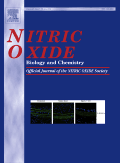
NITRIC OXIDE-BIOLOGY AND CHEMISTRY
Scope & Guideline
Connecting the Dots Between Nitric Oxide and Cancer Research
Introduction
Aims and Scopes
- Biological Mechanisms of Nitric Oxide and Hydrogen Sulfide:
The journal explores the biochemical pathways and physiological roles of nitric oxide and hydrogen sulfide, investigating their effects on various biological processes such as vasodilation, neurotransmission, and cellular signaling. - Therapeutic Applications and Innovations:
Research published in the journal highlights novel therapeutic strategies utilizing NO and H2S, including drug delivery systems, inhalation therapies, and their potential roles in treating various diseases, particularly cardiovascular and respiratory conditions. - Interactions with Other Biological Molecules and Pathways:
The journal examines the crosstalk between nitric oxide, hydrogen sulfide, and other signaling molecules, emphasizing the interplay of these gases with reactive oxygen species and their implications in health and disease. - Impact on Plant Physiology and Stress Responses:
Research also addresses the roles of NO and H2S in plant biology, particularly in responses to abiotic and biotic stress, showcasing their importance in agriculture and environmental science. - Systematic Reviews and Meta-Analyses:
The journal often publishes systematic reviews and meta-analyses that consolidate findings from various studies, providing comprehensive insights into the clinical implications of NO and H2S.
Trending and Emerging
- Nanotechnology in Drug Delivery:
There is a growing emphasis on the development of nanoparticle-based systems for targeted delivery of nitric oxide and hydrogen sulfide, showcasing advancements in materials science and therapeutic applications. - Role of Nitric Oxide in Neurodegenerative Diseases:
Recent studies indicate a significant increase in research exploring the involvement of nitric oxide in neurodegenerative diseases, highlighting its dual role as both a neuroprotective and neurotoxic agent. - Hydrogen Sulfide as a Therapeutic Agent:
Research focusing on hydrogen sulfide is emerging prominently, with increased investigations into its potential therapeutic roles, particularly in cardiovascular health and metabolic disorders. - Interplay Between Nitric Oxide and Gut Microbiome:
Emerging studies investigate the relationship between nitric oxide and gut microbiota, highlighting how NO may influence gut health and overall systemic inflammation. - Impact of Lifestyle Factors on Nitric Oxide Biology:
Recent publications emphasize the effects of dietary and lifestyle interventions on nitric oxide production and bioavailability, reflecting a trend towards personalized medicine and preventive health strategies.
Declining or Waning
- Traditional Therapeutic Applications:
There seems to be a waning focus on established therapeutic applications of nitric oxide, such as its use in treating conditions like angina and pulmonary hypertension, in favor of exploring more innovative and nuanced applications. - Basic Mechanistic Studies:
The journal has shifted towards more translational research, with fewer studies solely focused on basic mechanistic insights into nitric oxide and hydrogen sulfide signaling pathways, suggesting a move towards applied research with direct clinical implications. - Animal Model Studies:
There has been a noticeable reduction in the number of publications utilizing traditional animal models to study nitric oxide's effects, possibly due to the increasing emphasis on human clinical trials and translational research. - Focus on Nitric Oxide in Environmental Contexts:
Research addressing the environmental implications of nitric oxide, particularly in atmospheric chemistry and pollution, seems to be receiving less attention, as the journal narrows its focus to biomedical applications.
Similar Journals
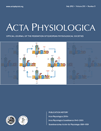
Acta Physiologica
Fostering Collaboration in Physiological SciencesActa Physiologica is a premier, peer-reviewed journal published by WILEY, dedicated to the dissemination of high-quality research across the field of physiology. With an impressive impact factor reflective of its Q1 category ranking in Physiology for 2023, this journal is a vital resource for researchers, professionals, and students alike, seeking to explore the complexities of biological systems. The journal is indexed with a commendable Scopus rank of #18 out of 193 in its category, placing it within the top 10% of its field, which underscores its influence and citation frequency within the academic community. Acta Physiologica publishes a variety of articles that address fundamental physiological concepts, innovative methodologies, and cross-disciplinary research. With its open access options, the journal ensures that cutting-edge knowledge is readily accessible, fostering an environment of collaboration and advancement in the study of physiology. Spanning from 2006 to 2024, the journal continues to be at the forefront of physiological research and education, encouraging the global sharing of knowledge through its comprehensive content.
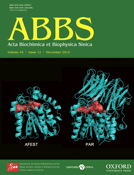
ACTA BIOCHIMICA ET BIOPHYSICA SINICA
Fostering Global Collaboration in Biochemistry and Biophysics.ACTA BIOCHIMICA ET BIOPHYSICA SINICA, an esteemed journal published by SCIENCE PRESS, is a leading platform in the fields of biochemistry, biophysics, and molecular biology. Based in the United Kingdom, this journal has consistently ranked in the Q2 category for Biochemistry, Biophysics, and Medicine (miscellaneous) in 2023, showcasing its commitment to high-quality research and innovation in life sciences. With a convergence period extending from 1996 to 2024, it features critical insights into biochemical and biophysical processes that underlie biological phenomena. Researchers and professionals seeking to stay at the forefront of discoveries will find its articles to be both informative and transformative. Although not an open-access journal, ACTA BIOCHIMICA ET BIOPHYSICA SINICA aims to advance knowledge and foster collaboration among scientists worldwide, emphasizing its role in the dynamic landscape of biomedical research.

PHYSIOLOGIA PLANTARUM
Connecting Researchers to the Frontiers of Plant SciencePHYSIOLOGIA PLANTARUM, published by WILEY, is a prestigious journal in the fields of plant science, physiology, and genetics, known for its impactful contributions since its inception in 1948. With an impressive impact factor and a consistent ranking in the Q1 and Q2 quartiles, it stands out in critical disciplines such as cell biology and biochemistry, ranking #24 in Plant Science with a remarkable 95th percentile standing. This journal primarily serves researchers and professionals committed to advancing the understanding of plant functions, responses, and their molecular mechanisms. Its broad scope allows for a diverse array of studies, ensuring that groundbreaking research is accessible to the global scientific community. Although it does not offer Open Access, PHYSIOLOGIA PLANTARUM remains a vital resource for scholars looking to stay at the forefront of plant biology and related fields.
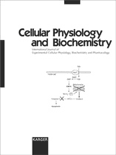
CELLULAR PHYSIOLOGY AND BIOCHEMISTRY
Connecting Researchers through Open Access ScholarshipCellular Physiology and Biochemistry is a premier Open Access journal published by the prestigious Cell Physiol Biochem Press GmbH & Co, dedicated to advancing research in the fields of physiology, biochemistry, and molecular biology. Since its inception in 1987 and transitioning to an Open Access model in 2013, the journal has established itself as a vital resource for the dissemination of high-quality research and reviews, showcasing innovative methodologies and groundbreaking findings in cellular processes. With an impressive ranking in the 2023 Scopus category as Q2 in Physiology and a robust percentile of 61, Cellular Physiology and Biochemistry is committed to fostering academic dialogue among researchers, professionals, and students alike. This journal not only provides unrestricted access to its articles, but also promotes the global sharing of knowledge, which is essential for the advancement of our understanding in these vital scientific areas. The journal's editorial team is dedicated to ensuring the highest standards of academic rigor and relevance, making it an indispensable addition to the libraries of those engaged in the life sciences.
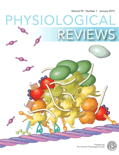
Physiological Reviews
Unveiling Insights, Shaping DiscoveriesPhysiological Reviews is a prestigious journal published by the American Physiological Society, dedicated to advancing our understanding of physiology across various domains. With an impressive impact factor that places it in Q1 quartiles for medicine, molecular biology, and physiology as of 2023, this journal is recognized as a leading source of high-quality reviews and research analyses. The journal has been a vital resource for the scientific community since its inception in 1945, providing in-depth and comprehensive insights that are crucial for both scholars and practitioners in the field. Although not an open-access publication, it remains widely accessible through institutional subscriptions, ensuring that crucial research findings are disseminated efficiently. With Scopus rankings that place it in the top percentile across multiple categories, Physiological Reviews continues to be an essential platform for the latest advancements and discoveries in physiology, making it indispensable for researchers, professionals, and students alike.

Protein & Cell
Transforming Understanding of Proteins and Cells for TomorrowProtein & Cell, published by Oxford University Press, is a distinguished international journal focusing on cutting-edge research in the fields of biochemistry, biotechnology, cell biology, and drug discovery. This open access journal, active since 2014, is dedicated to disseminating innovative findings that advance our understanding of protein functions and cellular processes, making it an essential resource for researchers, professionals, and students alike. With an impressive 2023 impact factor reflected in its Q1 ranking across multiple categories such as Biochemistry, Drug Discovery, and Cell Biology, 'Protein & Cell' stands at the forefront of scientific research, driving collaboration and discussion in the scientific community. Researchers can access the journal freely online, fostering a global exchange of knowledge and contributing to significant advancements in medicine and biotechnology. Located in the United Kingdom, the journal strives to be a pivotal platform for impactful research that influences future studies and applications.

JOURNAL OF BIOLOGICAL REGULATORS AND HOMEOSTATIC AGENTS
Unveiling Breakthroughs in Homeostatic Research.JOURNAL OF BIOLOGICAL REGULATORS AND HOMEOSTATIC AGENTS, published by BIOLIFE SAS, is a pivotal platform in the fields of Cancer Research, Endocrinology, Immunology, and Physiology, addressing fundamental aspects of biological regulation and homeostasis. Since its inception in 1987, this journal has consistently contributed to the advancement of knowledge, showcasing innovative research and breakthroughs that are instrumental for professionals, researchers, and students alike. Although categorized in the Q4 quartile across multiple disciplines, the journal offers a unique perspective that encourages exploration into underrepresented areas, underscoring its role in fostering scientific dialogue and collaboration. With ISSN 0393-974X and E-ISSN 1724-6083, the journal remains a crucial resource for those invested in understanding the complexities of homeostatic agents and their implications in health and disease. Based in Silva Marina, Italy, it invites contributions that broaden the horizons of contemporary biomedical research.

AMINO ACIDS
Your Gateway to Amino Acid ResearchAMINO ACIDS is a distinguished journal published by Springer Wien, specializing in the dynamic field of biochemistry, with a particular focus on the role of amino acids in biological processes. Since its inception in 1991, this journal has become a crucial resource for researchers and professionals, contributing valuable insights into the biochemical makeup and clinical applications of amino acids. With a commendable impact factor reflecting its high-quality publications, AMINO ACIDS consistently ranks in the Q2 category across biochemistry and organic chemistry domains as of 2023, demonstrating its significant influence within the scholarly community. The journal is indexed in Scopus and maintains strong rankings—59th in Organic Chemistry and 43rd in Clinical Biochemistry—highlighting its relevance and rigorous peer-review standards. While it currently does not offer open access options, the journal remains dedicated to advancing knowledge in both fundamental and applied biochemistry, making it an essential platform for disseminating cutting-edge research findings. For any academic seeking to explore the complexities of amino acids, AMINO ACIDS serves as an invaluable reference.

Medical Gas Research
Exploring Innovative Therapeutics in AnesthesiologyMedical Gas Research is a prominent academic journal dedicated to the field of anesthesiology and pain medicine, published by Wolters Kluwer Medknow Publications. With an ISSN of 2045-9912, this journal operates under a robust open access model, facilitating the wide dissemination of research findings across a global audience. Based in India, Medical Gas Research aims to present innovative studies and reviews that explore the therapeutic applications of medical gases, their mechanisms of action, and their impact on various neurological conditions. The journal has an admirable positioning within academic rankings, holding a Q2 classification in Anesthesiology and Pain Medicine and a Q3 designation in Neuroscience (miscellaneous) for 2023, reflecting its significant influence in these domains. Moreover, it ranks #35 out of 136 in the field of Anesthesiology, highlighting its contribution to advancing this vital area of medicine. Overall, the journal serves as an essential resource for researchers, professionals, and students aiming to stay abreast of the latest advancements and interdisciplinary approaches within the medical gas research landscape.

Function
Exploring the intersection of biology and medicine for impactful insights.Function is a pioneering open access academic journal published by Oxford University Press, dedicated to advancing research in the fields of Cancer Research, Cell Biology, Molecular Medicine, and Physiology. Since its inception in 2020, this journal has quickly established itself as a vital resource for researchers and professionals alike, achieving a commendable impact factor in the 2023 rankings, where it stands in the Q2 quartile across multiple categories. Located in the heart of the United Kingdom, Function aims to foster a global exchange of knowledge by providing free and unrestricted access to cutting-edge research, facilitating collaboration and innovation within the scientific community. With a robust focus on emerging discoveries and interdisciplinary approaches, this journal encourages contributions that unravel the complexities of biological functions, paving the way for transformative advancements in healthcare and related sciences. As it converges from 2020 to 2024, Function continues to be an invaluable platform for disseminating research that has the potential to shape the future of medicine and biology.